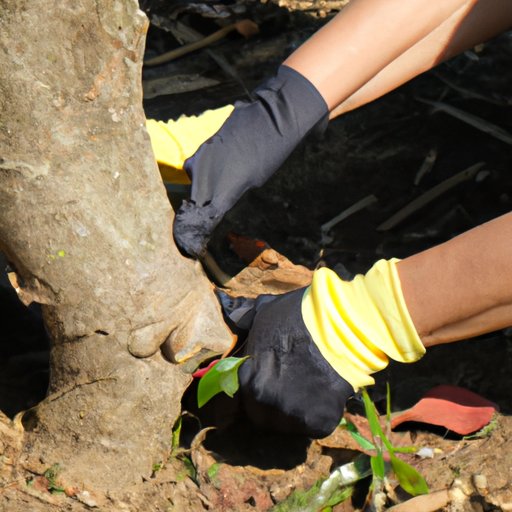Introduction
Trees are essential for our environment, providing oxygen, shade, food, and habitat for wildlife. Taking care of trees at home is an important part of maintaining a healthy environment. This article will provide helpful information on how to properly care for trees at home, including planting, mulching, pruning, protecting from pests and diseases, and avoiding compaction of soil.
Planting Trees
When planting a tree, it is important to choose a sunny location with well-drained soil. A good way to test soil drainage is to dig a hole about 8 inches deep. If the water does not drain away within 12 hours, then the soil is too wet and you should look for another spot. Tree roots need oxygen, so it is important to avoid soil that is too compacted.
Once the tree has been planted, it is important to water it regularly and deeply during dry periods. This will help keep the tree’s roots moist and ensure that it is getting enough water to stay healthy. It is also important to water the tree slowly and for a long period of time, as this will allow the water to soak down into the root system.
Mulching Around Trees
Mulching around trees is an important step in taking care of them. Mulch helps keep the roots cool and moist, which is essential for the health of the tree. It also helps prevent weeds from growing near the tree, which can compete with the tree for nutrients and water. When mulching around a tree, it is important to use organic materials such as wood chips or bark, as these will help improve the soil quality over time.
Pruning Trees
Pruning is an important part of taking care of trees. Pruning helps maintain the shape and health of the tree by removing dead or diseased branches. It also helps to promote new growth and increase air circulation, which can help prevent pests and diseases from attacking the tree. When pruning, it is important to use sharp pruning shears and make sure not to remove more than 25% of the tree’s foliage.

Protecting Trees from Pests and Diseases
It is important to protect trees from pests and diseases. One way to do this is to use natural methods whenever possible. For example, encouraging beneficial insects such as ladybugs and lacewings can help control pests. You can also use biological controls such as Bacillus thuringiensis (Bt) to control caterpillars and other pests. Finally, using fungicides and pesticides sparingly can help protect trees from diseases.
Avoid Compacting Soil Around Tree Roots
Compacted soil can harm tree roots and limit their ability to absorb water and nutrients. To avoid compaction, it is important to avoid walking or driving over the area around the tree. If possible, build pathways or driveways around the tree instead of directly over it. Additionally, avoid using heavy equipment near the tree, as this can cause compaction.
The benefits of not compressing the soil around the tree include improved air circulation, better water absorption, and increased nutrient uptake. This can help the tree grow faster and healthier, and can also help protect it from pests and diseases.
Conclusion
Taking care of trees at home is an important part of maintaining a healthy environment. By following the steps outlined in this article, you can ensure that your trees are healthy and thriving. These steps include choosing a sunny location with well-drained soil, watering trees regularly and deeply during dry periods, mulching around trees to keep roots cool and moist, pruning trees to maintain shape and health, protecting trees from pests and diseases, and avoiding compaction of soil around tree roots.
(Note: Is this article not meeting your expectations? Do you have knowledge or insights to share? Unlock new opportunities and expand your reach by joining our authors team. Click Registration to join us and share your expertise with our readers.)
